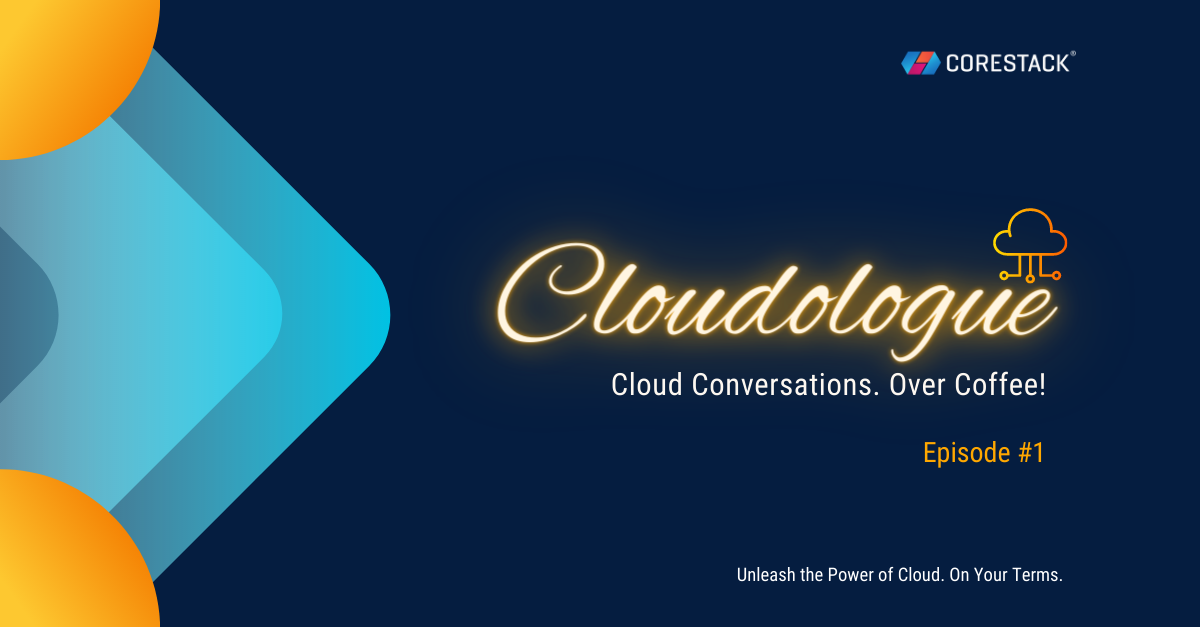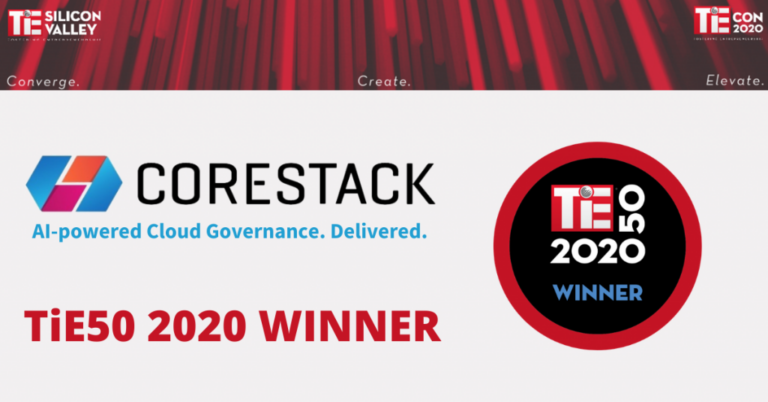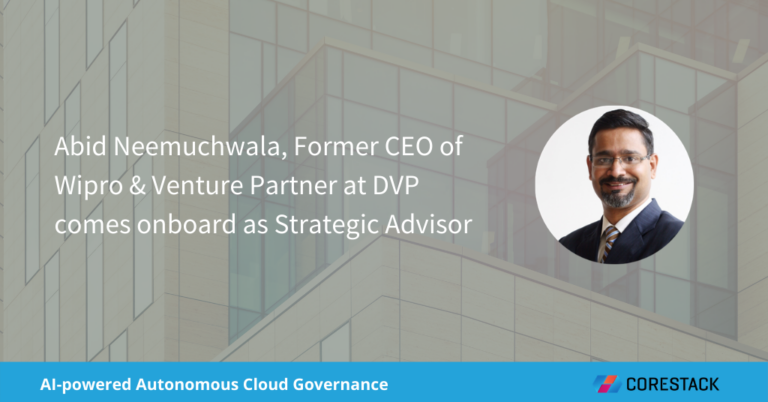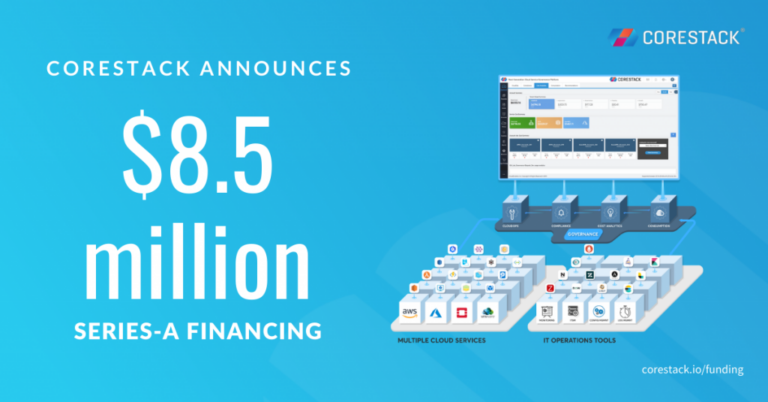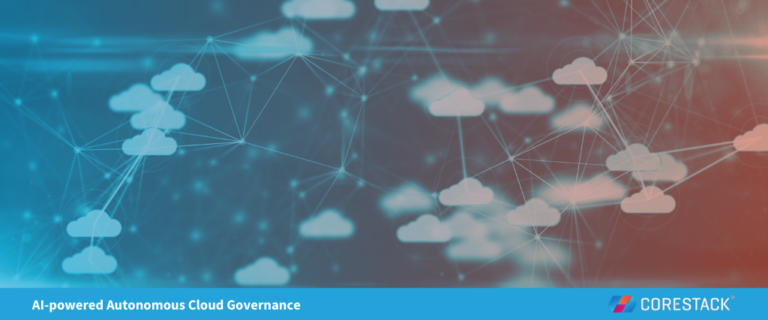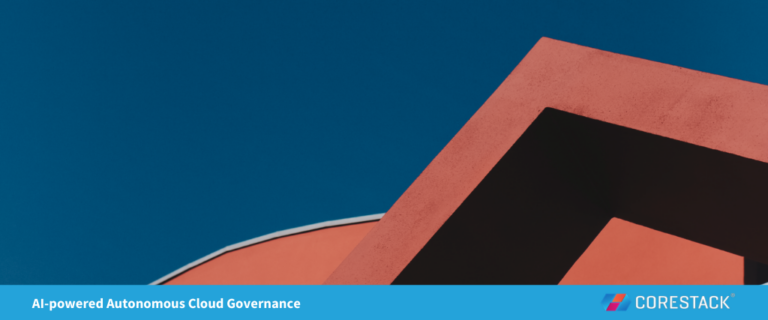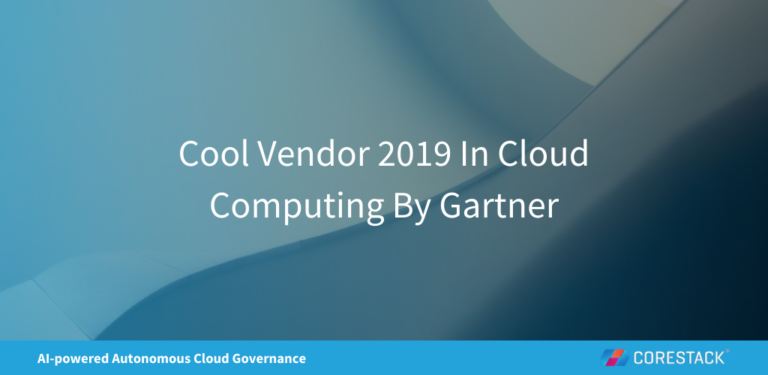Launching “Cloudologue”- CoreStack Fireside Chat Series Episode 1
Welcome to “Cloudologue” – CoreStack fireside chat series. Intrigued by the name? It is a derived portmanteau from the words “Cloud” + “Dialogue”. These fireside chats will be about the “CLOUD” with conversations raging from what's new and trending, what we are hearing from our customers, partners, industry insights, and a lot more.
With that short introduction, lets jump to the first episode.
In this session, we have Chris Voisey, Head of Customer Success in conversation with Venkatesh Perumal (Venky), Field CTO, CoreStack discussing the 2022 State of FinOps Report, the annual survey from FinOps Foundation; the leading industry body that champions culture of FinOps and financial accountability in cloud.
Transcript
Chris: Hi, my name is Chris Voisey and I run our Customer Success group here in North America for CoreStack. We're starting a new series of events and fireside chats called Cloudologue and we're gonna be sharing new information with you on a regular basis that we think is current and will be really helpful in your day-to-day business. Today joining me is Venky Perumal, who is our Field CTO and we're going to be talking about the State of FinOps report that was released by the FinOps Foundation and it was a great report that's now been made annual. We're in the second year of it and reading through it, there's quite a bit of information on here and I think it really relates to what our customers and prospective customers are looking for. There's some interesting trends emerging and it's really starting to show those and Venky, I know you've been involved with this for a little while so I want to get your take on it. And kind of set things up last year, there was about 44 questions and then this year in the report, they had about 65 and over 1000 people answered this survey to give them the results. Maybe you could tell everybody a little bit more about the survey and who took it.
Venky: Absolutely, Chris. Pleasure to doing this fireside chat with you. First of all, I think people need to understand what FinOps organization's vision is. They are organizations who are helping the cloud cost management professionals to have a better efficiency with respect to managing the cost itself. Lot of best practices are being defined So, any type of organization can pretty much come and look into it. What they have done successfully in this survey is they have really taken a step into the coverage of areas within various aspects of FinOps itself. Clearly one of the key areas is FinOps being practiced across the board and the answer is yes. The survey does provide us the data point with respect to various industries and we can see that leading the pack is financial services industry followed by healthcare, retail, and telecom. But there are, we cannot say that there is industry which are not but anybody who is moving into cloud are certainly adopting FinOps, that's number one. Number two, there’s a whole lot of coverage is on the challenges itself, there are about 17 challenges. And when I compare those challenges with the conversation that I'm having with the customers, they pretty much resonate, of course the order changes based on the priority, but clearly there that is being reflected. And the other aspect is they have covered various aspects of FinOps itself from an adoption standpoint with respect to the allocation, show back, chargeback, automation and so on.
Chris: And, I think we we've got a number of these topics we're going to cover over the next couple of days and weeks. Today let's just focus on maybe three. we'll focus on a little bit of the challenges and pain points that people have had forecasting, how we can better forecast things as well as you utilize automation in the process. And I thought one of the interesting points in the discussion of pain points themself was a great place to start. What do you think about the pain points that were shared by the FinOps foundation responses and how does this relate to what we've seen from our own customers here at CoreStack?
Venky: So, I'm not surprised with the number of challenges that every industry is going through. but of course, one would argue whether is it in the right order? Primarily because today, we are looking at all these data, keeping in mind, what maturity level are each organization isn't? Right. So, if somebody is in the run phase there, their challenges could be totally different than somebody who is in the crawl phase or somebody is in the walk phase. But overall, if I have to look at all these challenges, definitely every industry is going through that.
Chris: And how do you think CoreStack addresses this?
Venky: So one of the areas that you know, we have also seen in our customers is the number one where how do you motivate an engineer to go ahead and take action right today there are various aspects which stops an engineer to go ahead and take action one primary because you know, business does not see the value because you're looking at providing recommendation at the resource level. Can I get the recommendation at a business level or a workload level, which can help me go ahead and take action. That's number one. Number two, make it much more frictionless wherein you know, everybody is accountable, the development team is accountable for what they own so that they can go ahead and take action. They know what the resource stands for, that's number two. Number three make the change management process and the whole workflow end to end bringing a lot of automation which can help adopt, you know, implementing all these recommendations in a timely fashion.
Chris: Right. And we'll talk a little bit more about that as we move along here too. So essentially, you're saying that we're bringing it back to the business and tying in the engineers which makes a tremendous amount of sense. The next conversation on this kind of related is, you know, as you're allocating your cloud spend, you know, it's interesting to look at how we're doing it now in the past with native environments, we would go and we knew what, we were allocating if we're using bare metal servers. We could say this was devoted to this, we'd fire one up in our production environment, our QA developers and they used their own boxes, but now in the cloud it's a little different. We have them everywhere and they can get a little bit out of control, and I know tagging has been a strong solution to help us make that transition. How do you feel on tagging? And again, maybe talk a little bit about what CoreStack does for tagging?
Venky: Absolutely. So, number one, for any organization to understand what cost they is needed to get that visibility. So, while the hyperscalers provide information with respect to what we have consumed at a service level. If I must drill it down, I really need to have some sort of intelligence built in in house and go ahead and look at it at the third-party tool which can allow me to go ahead and drill down on the data with respect to what am I consuming? How can I allocate this cost? It becomes even more complex when you're not looking at the direct cost alone because now you have shared cost. You are consuming resources from a third-party software which is in the marketplace. How do I ensure that I bring in those costs as well? or I'm using reservations where you have done prepaid during the beginning of the year, how do I go ahead and amortize it? So, all those visibilities totally lie in the way that you've structured your meta definition or metadata. So, one of the solutions is tagging right, so can I go ahead and tag my resources? Can I go ahead and tag my resource group level, or can I tag my account or subscription in the first place? So, tagging alone cannot solve the problem because it needs to be clubbed along with some sort of business rules when something doesn't happen. What should I consider as my tag? Right, so and that is the area where CoreStack brings in the tagging governance one basically allowing every organization to enforce tagging in the first place. So, once you enforce then it becomes much more easier for you to mature in the tagging governance to see what sort of business rules that can be said to make sure that none of the costs that I'm getting is unallocated because at the end of the day you need to know where should I go ahead and attribute this cost to should this go to a business unit? Should this go to a project, where should it go to and then if you must go and take that particular cost and feed it into the financial tool then becomes how do I charge back? So, and tagging plays a huge role of course, is that the only way to solve the problem? No, but today at least that is something which is largely followed in all the organizations that we have been engaged with?
Chris: Yeah, no, and that's true and I know that we're just still at the beginning of the journey on tagging, there's a lot of things that are happening and I know during one of the webinar calls as the FinOps Foundation was presenting their report introducing it, they were talking about how horrible solution tagging is, but it's one of those evil, necessary things that we have, Hyperscalers are working on it, everyone's coming up with solutions, but one of the things I know CoreStack is already starting to do things in here and bringing into this, is there any more that's on the horizon that you see with tagging that is worth bringing up now?
Venky: No, I mean we are also looking at various other ways of addressing this problem, but of course what we really want to do is we want to help every organizations who are in the various stages, So anybody who is in the crawl phase, what is necessary for them to quickly kickstart or implement FinOps practicing the organization is something that we are very focused towards and similarly, the whole chain, things change is when somebody is in the run phase because anybody who's in the run phase from a FinOps standpoint, they have everything almost set right? What is not set is still, how do I go ahead and allocate my shared cost that's still a major problem or an issue that we have seen in the larger organizations.
Chris: Yeah, you can. Absolutely. And I think that having the tagging work across various cloud providers is just huge just today alone. I heard another customer as we're bringing them on board and that's they were just praising that. So let's move along to the next topic which is about forecasting, you know, which kind of fits nicely with tagging because we can start to see where the environments are. We can be a little more predictable in the State of FinOps report they represented where people are in setting up their forecasting benchmarks and it depended where they were in the maturity model. Maybe you can talk a little bit about that.
Venky: The data is pretty interesting when I look at it right, anybody who is in the run phase, they have a variance of plus or -5%, of course it has gone from 12 to 5 which is a good improvement because which means you are forecasting really well and this is only going to go increase provided you have those practices well set within the organization itself. Can I go ahead and look at my budget every week, can I go ahead and have a cadence every month, How do I track my budgets against the forecast? Can I go ahead and change my forecast based on seasonality. those aspects have to be taken care number two. Can I go ahead and build my entire budget based on certain projects or certain tags or based on business units? So today if you look at it while hyperscalers do provide certain amount of budgeting capability but it does not, drill down to the way that enterprises would really want to go ahead and look at it. Can I look at the historical data and now take informed position because everything depends upon the data. If you're looking at, you know, if you've just started budgeting, looking at last three months of data is really not going to help you, you have to look at least two seasons of data to really strengthen your forecasting because that's how you'll know whether you're forecasting is going well.
Chris: Yeah. And then when once you take that forecasting, obviously you want to make it more predictable, and you want to have ways to manage the show backs and chargebacks as well and know that what you're doing is properly being forecasted. So that kind of ties into the next topic which is talking about automation right? And I know that automation is a very strong topic here and there was a bit of you know interesting information shared on where that is and where people are in the life cycle and what's holding them back, maybe you could have a few words on that.
Venky: So, one I think looking at the results, it's pretty clear that everybody is moving towards setting up automation right? Which is certainly a good, way to proceed as you continue to grow in the cloud and why it is very important is because if you continue to go ahead and download the data, put it in excel sheet, it's not going to be consistent. If you really need consistency, automation is going to be the backbone of everything. So, once you set up automation with respect to reporting, you can go ahead and schedule it have the consistent data reporting in number two, we spoke about, spoke about tagging, how do we ensure that, you know, tagging itself is fully automated whenever there is an incorrect tag in the system. Is that how do we go ahead and remediate that? Because I've seen there are larger organizations who have at least three or four people who are just managing tag from manual standpoint. and that is something that you can totally take care if you have the right level of automation built from a tagging governance standpoint. Number two, I clearly is anomalies, how do I ensure that I look at all the trending data and see if there are anomalies, but anomalies are not looking at the end of the month Rather automation should enable me to act as in when it is happening. Right? So, a Bitcoin mining can happen, or a security hack can happen, which can all of a sudden spike your cloud spends. So, you need be waiting for the end of the month to see a million-dollar bill more than what it's supposed to be and then go take some reactive action. So, automation really helps in identifying anomalies having the report done in the right way. Also implementing a lot of recommendations with respect to the optimization that an engine provides, or a third-party tool provides.
Chris: Yeah. And again, I know we've seen a lot on the reporting side alone, just a side commentary. And that is, you know, having automated that, reporting, seeing it in real time is really a game changer because that's what people are expecting. You know, I remember in my past where I've had to make reports and we're putting it into various spreadsheets and other documents and pulling it out by the time you get finished, the numbers aren't even the same as what they are at that moment. So, you know, these go, hand in hand as well. Let's next talk about what's stopping people, why aren't we automating more. And I found this one interesting. People seem to be our biggest barrier. What do you think here on the are what's holding us back?
Venky: So, this brings me down to the challenge that we had in the challenges slide right where, you know, getting engineers to take action and why technical resources are still kind of a bottleneck? I shouldn't say bottleneck. It is more about again, the knowledge gap at the, at the base which the cloud adoption is happening, the newer services are coming, the technical resources they need to continue to learn and then go ahead and apply that knowledge into the real real-life scenarios. And that is definitely a problem. How, how can, you know, someone who has to take care of the business problems day to day problems, you expect them to go ahead and take action when a new service is coming. That is delaying the, the automation capability itself, because you have set a lot of legacy reporting is already set, You need to have some sort of dedicated timecard out to build this automation, So that's number one, Number two, the automation should enable not a silent action. It has to work along with the entire ecosystem of tools. It needs to go grab the data from the hyperscaler. It needs to derive some insights and based on the insights it should go ahead and allow certain actions to be taken so that everything has to be interconnected. Automation has to play a longer role. But in this case the change management itself stops you from doing it. If you have too many controls too many gates, if you put it under each stage then that becomes a stumbling block for you. So typically, if you look at those are the two things that I personally see where in technical resources have to continuously, learn, learn, learn and third it's the overall process which is change management process, which is set within the organization that can pull you back.
Chris: Yeah. And I think what might be useful for people, maybe let's talk a little bit about what CoreStack does and how we add value to that process.
Venky: Absolutely. So, the majority of the rudimentary tasks which every organization does right, everything is already prebuilt and automated. and one of the key things that we have done is with respect to any newer services that comes in or introduced by the hyperscalers, we have a mechanism to go ahead and integrate that quickly. Go ahead. And since every recommendation that CoreStack provides is driven through a policy, it's more about configuration than building a new code. So, once I configure those new rules that can help me in anomaly, it can help me in cost optimization, it can help me in reporting, it can help me notifications. So, all those things are driven through the automation engine within CoreStack which is powered by either the policies or the templates which is all, which is there in CoreStack. So, it is not only built for your current problem that you want to address, but it is also ready for any newer services that you would be conceiving at some point in time.
Chris: So then once we have the automation setup, you're good, right?
Venky: you're pretty good because the tool has the out of the box integrations and has all the plugins with the enterprise ecosystem tools. But if there are any specific tools in the enterprise, the integration is straightforward. So, it works along with the enterprise tools and adheres to the change management process as well. Right. So, we try to make sure that there is very little manual intervention wherever automation can be put in, we have done that through the tool.
Chris: Well, great, well, thanks very much, this has been, I think some great information. If there was one other topic that you wanted to cover here before we go, what might that be?
Venky: Certainly, anomalies are something that we should talk about because you would have seen the survey right, it's about 30 billion cloud revenue. The number of people who took the survey, the cloud spend amount to 30 billion. But the market itself is going beyond 360 billion, which is almost one billion spend per day. so, with the large consumption, I think it is important for everyone to know what is happening in real time. So, the real time data insights is very important. I think we should talk about the cost anomalies is one aspect that I would love to deep dive
Chris: Yeah. And I think this really brings us to a good, launch point too. In the future, we have a few other topics coming and we'll definitely dive more into this anomaly detection because I think I agree with you this is a great topic. Let's take a look at maybe some of the maturity models and you know a very popular topic which gets easier in my opinion with cloud spend is, chargebacks and show backs how to work with that. We'll talk about some unit metrics and let's revisit that topic on automation because I think this is kind of the piece that ties everything else together. So again, thank you for joining me today. I appreciate your time, Venky I think we're gonna have a great set of these coming out. I encourage everybody to check back with us. We'll send you some notifications on the future ones that are being published but look for these on a regular basis and thank you for watching our first Cloudologue
Venky: Thanks everyone and thanks Chris

